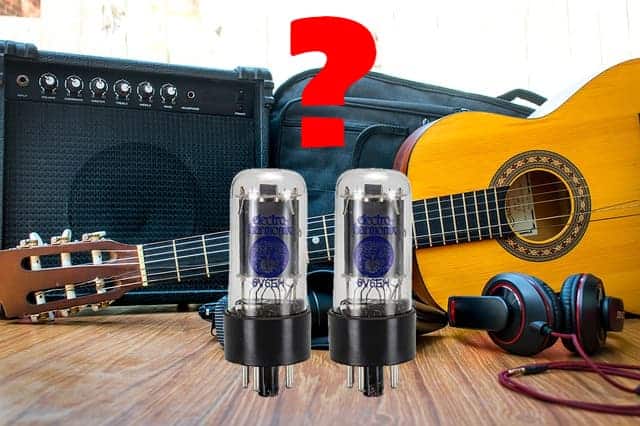
After purchasing a new acoustic guitar, I soon found myself searching for ways how I would ‘amplify’ the sound for playing louder and potentially gigging at small venues.
After looking at multiple acoustic amps this got me wondering, do acoustic amps use the same amplification technology as tube amps?
If not how do they differ? Here is what I found out…
Do acoustic guitar amplifiers have power tubes?
Acoustic amplifiers do not use ‘power tubes’ instead they use ‘solid state’ technology to amplify a guitar signal. The reason is that acoustic guitar amps function more like a ‘PA system.’ Replicating a large spectrum of frequencies to accurately amplify an acoustic guitar signal without ‘coloring’ or ‘distorting’ the sound which is typical of tube amps.
What are Solid State Amps?
Solid sate technology refers to using ‘transistors’ and ‘diodes’ to amplify the signal instead of ‘power tubes’ traditionally adopted by tube/valve amps.
Some
The power amplification section including the diodes and transistors which is the ‘bread and butter’ that amplify the pre-amp section for the main sound you hear from the amp.
Why Acoustic Amps Do Not Use Power Tubes?
As mentioned acoustic amplifiers are designed to replicate and amplify the ‘clean’ and ‘clarity’ of an acoustic guitar without changing the tone. An acoustic amplifier with power tubes would not be ideal for small to medium sized gigs.
The reason being the sound will ‘distort’ when the volume reaches a certain level which is not what the typical acoustic guitar sound is accustomed for.
Acoustic amps are designed to replicate and project the acoustics tone as transparently as possible. Highlighting a wide range of frequencies without coloring the sound and over emphasizing certain frequencies such as the ‘mids’ and ‘highs’ which is typical of regular tube amps.
Similarly, some acoustic amps are designed for amplifying vocals including a microphone XLR which usually a clean voicing is required. Power tubes would distort the usual clean voicing and would not replicate the wide range of frequency required for amplifying vocals.
On the other hand, tube amplifiers exists to provide saturated and the typical ‘tube distortion’ tone for rehearsal and small gig size venues when given enough volume.
Enough volume essentially ‘pushes’ the tubes allowing them to ‘break-up’ creating a distorted sound with saturation. This is distortion is ideal for rock, metal, punk any lead tone and most genres of music.
For an acoustic guitar which needs the ‘cleanest voicing’ for amplification, a distorted guitar signal is very undesirable.
Why Acoustic Amps are Solid State
As we have discussed the sound and tone that power tubes produce is not preferred for an acoustic amp. An acoustic amp being
The first being that power tubes are delicate and more unreliable as they are typically housed in a glass chassis that can crack when transferring to gigs.
Portability
These power tubes also take up a lot of space meaning that the amp will generally be bigger and weigh more than the typical solid state. An amp with more parts means more cost for manufacturer and the shipping resulting in more cost for the customer.
A bigger and heavier amp results in a less portability. As most live acoustic musicians know, portability is an important feature to an acoustic amp.
It is a very important aspect when it comes to street performers, coffee shop musicians and playing a small
The reason is that acoustic guitarists are usually the type to play in an array of venues with a busy gigging schedule.
Lugging a heavy acoustic amp is not necessary as acoustic guitarists can bring as little as their guitar, cables and a small mixer for connecting to PA without needing to carry a heavy amp around from gig to gig.
Being solid state in design is also beneficial for acoustic amps as it increases the functionality and versatility of sounds and textures the amp can produce.
Versatility
For example, acoustic amps are known for having ‘effects‘ such as reverb, chorus, echo and other effects typical to add to an acoustic guitar tone. This would be a difficult feature to include on a tube amp without external effects or pedals.
Being solid state also allows the amp to include other useful digital features which are absent on tube amps. These include an aux connection for playing external devices such as on a phone for playing along with backing tracks.
Another important feature as previously
How to play with an Acoustic Amp Live

Acoustic amps are also solid state in nature as unlike valve amps, they do not need to be cranked nearly as loud as a valve amp.
Most acoustic amps are 50 – 200-watts which easily packs enough volume for a small to medium sized gig. Easily loud enough for a typical microphone placed in front of the amp to be relayed to a mixing desk.
Direct Method
Most acoustic amps have the advantage of including a ‘direct input’ by the rear panel to connect directly to a venues PA system. Some amps allow the player to remain in control of the EQ, effects and tone of the acoustic while the sound engineer only has direct control of the overall volume and levels.
Whereas, some acoustic amps only allow the player control of the digital effects while the sound engineer has control over the tone and overall volume. This all depends on the amp.
Miking the Amp
The other method is placing a microphone near the cone of the amps speaker near the ‘sweet spot’ which you will need to discover for yourself.
This allows for more tone customization and allows you more control over your tone and sound. However, this method is considered more impractical and more time consuming to set up and get right.
Whatever method you choose when playing live with your amp is up to you as the player.
Do Acoustic Electric Guitars Need Amps?
The answer to this question depends on your tastes and preferred method of recording, practicing and playing live with your electric acoustic.
Obviously, all acoustic guitars create their own sound projection due to the sound vibration from the strings resonating inside the body and back out through the sound hole. This is fine for home practice and other applications.
However, when the sound from acoustic sound is required to be projected and amplified to fill a space for a gig or record. You can alternatively use the guitars pickup to connect to an acoustic amp for playing live or recording.
The guitar pickup in an electric acoustic has the benefit of functioning to project the acoustics sound with an acoustic amp. The pickup that provides the signal for the amp is connected to a pre-amplifier that has it’s own designated volume and EQ controls that does not dull or affect the acoustics of the guitar.
This is the most convenient way to play live by playing though an external amp. If it has a ‘direct’ input to PA system then this is an easy live set up. Alternatively you can also set a microphone to the cone of the speaker
Miking the Sound Hole
Alternatively you can play live without an amp with your acoustic by setting a microphone in close proximity to the sound hole instead of connecting to an external amp.
In my opinion, this technique reproduces the true sound, harmonics and frequencies of an acoustic than using the guitars internal pickup. I can understand that plugging in the guitars jack and fiddling with the amps EQ is easier than setting up and sound checking a microphone to the sound hole.
However, recording a microphone close to the sound hole, in my opinion, creates a more lush, rich, fuller and overall truer sound of the acoustic. The direct guitar pickup tone is flat, tinny and trebley compared to using the microphone method.
The answer to the question is that you can record and play live without an amp. Whatever method depends on your tastes and preferred option as the artist.
Related Questions
Can you use an acoustic guitar with a regular amp?
Electric guitar amps are not designed for use with an acoustic which will sound unnatural and usually too harsh within the mid and
Can you play acoustic guitar at a gig without an acoustic amp?
If the venue has a PA system you can connect directly to the mixing board or for more control use your own external mixer interface directly connected to the venues PA. Without a PA you will need to use an amp as a source of amplification.
